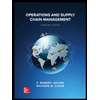A firm wants to determine its production rate over the next twelve months. expected demand for its product is 30, 80, 90, 75, 80, 100, 95, 75, 200, 125, 130, 120 units for months 1 through 12 respectively. The product is perishable and thus cannot be stored from month to month. The loss per unit not sold is $8, and the penalty per unit short is $15. Because of the nature of the production process, the difference between production levels of two successive months cannot be more than 20. That is, if produce 50 in month 4, the production in month 5 can be between 30 and 70. Formulate this problem and solve to determine the optimal production schedule.
A firm wants to determine its production rate over the next twelve months. expected demand for its product is 30, 80, 90, 75, 80, 100, 95, 75, 200, 125, 130, 120 units for months 1 through 12 respectively. The product is perishable and thus cannot be stored from month to month. The loss per unit not sold is $8, and the penalty per unit short is $15. Because of the nature of the production process, the difference between production levels of two successive months cannot be more than 20. That is, if produce 50 in month 4, the production in month 5 can be between 30 and 70. Formulate this problem and solve to determine the optimal production schedule.
Practical Management Science
6th Edition
ISBN:9781337406659
Author:WINSTON, Wayne L.
Publisher:WINSTON, Wayne L.
Chapter2: Introduction To Spreadsheet Modeling
Section: Chapter Questions
Problem 20P: Julie James is opening a lemonade stand. She believes the fixed cost per week of running the stand...
Related questions
Question
A firm wants to determine its production rate over the next twelve months. expected demand for its product is 30, 80, 90, 75, 80, 100, 95, 75, 200, 125, 130, 120 units for months 1 through 12 respectively. The product is perishable and thus cannot be stored from month to month. The loss per unit not sold is $8, and the penalty per unit short is $15. Because of the nature of the production process, the difference between production levels of two successive months cannot be more than 20. That is, if produce 50 in month 4, the production in month 5 can be between 30 and 70. Formulate this problem and solve to determine the optimal production schedule.
Expert Solution
This question has been solved!
Explore an expertly crafted, step-by-step solution for a thorough understanding of key concepts.
This is a popular solution!
Trending now
This is a popular solution!
Step by step
Solved in 2 steps with 4 images

Recommended textbooks for you

Practical Management Science
Operations Management
ISBN:
9781337406659
Author:
WINSTON, Wayne L.
Publisher:
Cengage,

Operations Management
Operations Management
ISBN:
9781259667473
Author:
William J Stevenson
Publisher:
McGraw-Hill Education

Operations and Supply Chain Management (Mcgraw-hi…
Operations Management
ISBN:
9781259666100
Author:
F. Robert Jacobs, Richard B Chase
Publisher:
McGraw-Hill Education

Practical Management Science
Operations Management
ISBN:
9781337406659
Author:
WINSTON, Wayne L.
Publisher:
Cengage,

Operations Management
Operations Management
ISBN:
9781259667473
Author:
William J Stevenson
Publisher:
McGraw-Hill Education

Operations and Supply Chain Management (Mcgraw-hi…
Operations Management
ISBN:
9781259666100
Author:
F. Robert Jacobs, Richard B Chase
Publisher:
McGraw-Hill Education


Purchasing and Supply Chain Management
Operations Management
ISBN:
9781285869681
Author:
Robert M. Monczka, Robert B. Handfield, Larry C. Giunipero, James L. Patterson
Publisher:
Cengage Learning

Production and Operations Analysis, Seventh Editi…
Operations Management
ISBN:
9781478623069
Author:
Steven Nahmias, Tava Lennon Olsen
Publisher:
Waveland Press, Inc.